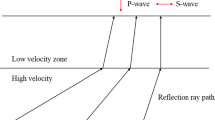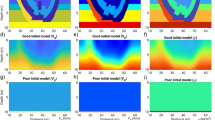Abstract
Shallow-seismic full-waveform inversion (FWI) is becoming increasingly popular for the reconstruction of the shallow-subsurface model in near-surface geophysics. Because Rayleigh waves dominate the vertical component of the shallow-seismic recording, FWI mainly fits Rayleigh waves in the observed data, while the utilization and fitting of P waves in the data are usually overlooked. The appropriate use of the body-wave signal in shallow-seismic FWI remains a problem. We propose herein a wavefield-separated full-waveform inversion (WSFWI) method to make better use of the P-wave signal in the shallow-seismic data. The WSFWI method mainly contains two steps: (1) separating the P wave from the observed data and applying an acoustic FWI to it for the reconstruction of the P-wave velocity model, and (2) fixing the P-wave velocity model and applying an elastic FWI to the entire recording for the reconstruction the S-wave velocity model. We show that Rayleigh and P waves are sensitive towards different areas of the model, and therefore, WSFWI can better utilize the sensitivity kernel of P waves to improve the accuracy of the reconstructed P-wave velocity model. A synthetic example shows that WSFWI outperforms the FWI that uses the whole recording simultaneously, especially in the reconstruction of the P-wave velocity model. It also proves that WSFWI is able to avoid (mitigate) crosstalk imposed from the S-wave velocity to the P-wave velocity models. We apply both the conventional FWI and WSFWI to a field data set acquired in Olathe, Kansas, USA. The field example shows that the S-wave velocity model can be reconstructed with high robustness in both the FWI and WSFWI results. Both the conventional FWI and WSFWI nicely fitted the observed Rayleigh wave, while WSFWI also fitted the P waves in the observed data and reconstructed the P-wave velocity model with relatively higher reliability.













Similar content being viewed by others
Data Availability
The synthetic and field data presented in this study are available upon request to the corresponding author.
References
Barnes, C., & Charara, M. (2009). The domain of applicability of acoustic full-waveform inversion for marine seismic data. Geophysics, 74(6), WCC91–WCC103.
Bohlen, T. (2002). Parallel 3-D viscoelastic finite difference seismic modelling. Computers & Geosciences, 28(8), 887–899.
Brossier, R., Operto, S., & Virieux, J. (2009). Seismic imaging of complex structures by 2D elastic frequency-domain full-waveform inversion. Geophysics, 74(6), WCC105–WCC118.
Bunks, C., Saleck, F. M., Zaleski, S., & Chavent, G. (1995). Multiscale seismic waveform inversion. Geophysics, 60(5), 1457–1473.
Choi, Y., & Alkhalifah, T. (2012). Application of multi-source waveform inversion to marine streamer data using the global correlation norm. Geophysical Prospecting, 60, 748–758.
Dokter, E., Köhn, D., Wilken, D., De Nil, D., & Rabbel, W. (2017). Full waveform inversion of SH-and Love-wave data in near-surface prospecting. Geophysical Prospecting, 65, 216–236.
Fabien-Ouellet, G., Gloaguen, E., & Giroux, B. (2017). Time domain viscoelastic full waveform inversion. Geophysical Journal International, 209(3), 1718–1734.
Forbriger, T., Groos, L., & Schäfer, M. (2014). Line-source simulation for shallow-seismic data. Part 1: theoretical background. Geophysical Journal International, 198(3), 1387–1404.
Gao, L., Pan, Y., Tian, G., & Xia, J. (2018). Estimating Q factor from multimode shallow-seismic surface waves. Pure and Applied Geophysics, 175(8), 2609–2622.
Gao, L., Pan, Y., & Bohlen, T. (2020). 2D multi-parameter viscoelastic shallow-seismic full waveform inversion: Reconstruction tests and first field-data application. Geophysical Journal International, 222, 560–571.
Gao, L., Pan, Y., Rieder, A., & Bohlen, T. (2021). Multiparameter viscoelastic full waveform inversion of shallow seismic surface waves with a preconditioned truncated-Newton method. Geophysical Journal International, 227, 2044–2057.
Gélis, C., Virieux, J., & Grandjean, G. (2007). Two-dimensional elastic full waveform inversion using Born and Rytov formulations in the frequency domain. Geophysical Journal International, 168(2), 605–633.
Groos, L., Schäfer, M., Forbriger, T., & Bohlen, T. (2014). The role of attenuation in 2D full-waveform inversion of shallow-seismic body and Rayleigh waves. Geophysics, 79(6), R247–R261.
Groos, L., Schäfer, M., Forbriger, T., & Bohlen, T. (2017). Application of a complete workflow for 2D elastic full-waveform inversion to recorded shallow-seismic Rayleigh waves. Geophysics, 82(2), R109–R117.
Irnaka, T.M., Brossier, R., Métivier, L., Bohlen, T. and Pan, Y., (2019), Towards 3D 9C Elastic Full Waveform Inversion of Shallow Seismic Wavefields-Case Study Ettlingen Line. In:81st EAGE Conference and Exhibition 2019. European Association of Geoscientists & Engineers.
Köhn, D., Wilken, D., De Nil, D., Wunderlich, T., Rabbel, W., Werther, L., Schmidt, J., Zielhofer, C., & Linzen, S. (2019). Comparison of time-domain SH waveform inversion strategies based on sequential low and bandpass filtered data for improved resolution in near-surface prospecting. Journal of Applied Geophysics, 160, 69–83.
Köhn, D., De Nil, D., Kurzmann, A., Przebindowska, A., & Bohlen, T. (2012). On the influence of model parametrization in elastic full waveform tomography. Geophysical Journal International, 191, 325–345
Krampe, V., Pan, Y., & Bohlen, T. (2019). Two-dimensional elastic full-waveform inversion of Love waves in shallow vertically transversely isotropic media: Synthetic reconstruction tests. Near Surface Geophysics, 17, 449–461.
Luo, Y., Xia, J., Miller, R., Xu, Y., Liu, J., & Liu, Q. (2008). Rayleigh-wave dispersive energy imaging using a high-resolution linear Radon transform. Pure and Applied Geophysics, 165(5), 903–922.
Manukyan, E., & Maurer, H. (2020). Elastic vertically transversely isotropic full-waveform inversion using cross-gradient constraints—An application toward high-level radioactive waste repository monitoring. Geophysics, 85(4), R313–R323.
Mecking, R., Köhn, D., Meinecke, M., & Rabbel, W. (2021). Cavity detection by SH-wave full-waveform inversion—A reflection-focused approach. Geophysics, 86(3), WCC123–WCC137.
Miller, R. D., Xia, J., Park, C. B., & Ivanov, J. M. (1999). Multichannel analysis of surface waves to map bedrock. The Leading Edge, 18(12), 1392–1396.
Mulder, W. A., & Plessix, R. E. (2008). Exploring some issues in acoustic full waveform inversion. Geophysical Prospecting, 56(6), 827–841.
Nuber, A., Manukyan, E., & Maurer, H. (2016). Ground topography effects on near-surface elastic full waveform inversion. Geophysical Journal International, 207(1), 67–71.
Pan, Y., Gao, L., & Bohlen, T. (2018). Time-domain full-waveform inversion of Rayleigh and Love waves in presence of free-surface topography. Journal of Applied Geophysics, 152, 77–85.
Pan, Y., Gao, L., & Bohlen, T. (2019). High-resolution characterization of near-surface structures by surface-wave inversions: From dispersion curve to full waveform. Surveys in Geophysics, 40(2), 167–195.
Pan, Y., Gao, L., & Shigapov, R. (2020). Multi-objective full waveform inversion of shallow-seismic wavefields. Geophysical Journal International, 220, 1619–1631.
Plessix, R. E. (2006). A review of the adjoint-state method for computing the gradient of a functional with geophysical applications. Geophysical Journal International, 167(2), 495–503.
Richwalski, S., Roy-Chowdhury, K., & Mondt, J. C. (2000). Practical aspects of wavefield separation of two-component surface seismic data based on polarization and slowness estimates. Geophysical Prospecting, 48(4), 697–722.
Romdhane, A., Grandjean, G., Brossier, R., Réjiba, F., Operto, S., & Virieux, J. (2011). Shallow-structure characterization by 2D elastic full-waveform inversion. Geophysics, 76(3), R81–R93.
Sears, T. J., Singh, S. C., & Barton, P. J. (2008). Elastic full waveform inversion of multi-component OBC seismic data. Geophysical Prospecting, 56, 843–862.
Smith, J. A., Borisov, D., Cudney, H., Miller, R. D., Modrak, R., Moran, M., Peterie, S. L., Sloan, S. D., Tromp, J., & Wang, Y. (2018). Tunnel detection at Yuma proving ground, Arizona, USA. Part 2: 3D full-waveform inversion experiments. Geophysics, 84(1), 1–98.
Solano, C.P., Stopin, A., & Plessix, R.E., (2013). Synthetic study of elastic effects on acoustic full waveform inversion. In: 75th EAGE Conference & Exhibition incorporating SPE EUROPEC 2013 (pp. cp-348). European Association of Geoscientists & Engineers.
Tarantola, A. (1984). Inversion of seismic reflection data in the acoustic approximation. Geophysics, 49(8), 1259–1266.
Teodor, D., Comina, C., Khosro Anjom, F., Brossier, R., Valentina Socco, L., & Virieux, J. (2021). Challenges in shallow target reconstruction by 3D elastic full-waveform inversion—Which initial model? Geophysics, 86(4), R433–R446.
Tran, K. T., McVay, M., Faraone, M., & Horhota, D. (2013). Sinkhole detection using 2D full seismic waveform tomography Sinkhole detection by FWI. Geophysics, 78(5), R175–R183.
Tran, K. T., Mirzanejad, M., McVay, M., & Horhota, D. (2019). 3-D time-domain Gauss-Newton full waveform inversion for near-surface site characterization. Geophysical Journal International, 217(1), 206–218.
Tromp, J. (2020). Seismic wavefield imaging of Earth’s interior across scales. Nature Reviews Earth & Environment, 1, 40–53.
Tromp, J., Tape, C., & Liu, Q. (2005). Seismic tomography, adjoint methods, time reversal and banana-doughnut kernels. Geophysical Journal International, 160(1), 195–216.
Virieux, J., & Operto, S. (2009). An overview of full-waveform inversion in exploration geophysics. Geophysics, 74(6), WCC1–WCC26.
Xia, J., Miller, R. D., & Park, C. B. (1999). Estimation of near-surface shear-wave velocity by inversion of Rayleigh wave. Geophysics, 64(3), 691–700.
Xia, J., Xu, Y., Luo, Y., Miller, R. D., Cakir, R., & Zeng, C. (2012a). Advantages of using multichannel analysis of Love waves (MALW) to estimate near-surface shear-wave velocity. Surveys in Geophysics, 33(5), 841–860.
Xia, J., Xu, Y., Miller, R. D., & Ivanov, J. (2012b). Estimation of near-surface quality factors by constrained inversion of Rayleigh-wave attenuation coefficients. Journal of Applied Geophysics, 82, 137–144.
Yilmaz, Ö. (2015). Engineering seismology with applications to geotechnical engineering. Society of Exploration Geophysicists. https://doi.org/10.1190/19781560803300
Zeng, C., Xia, J., Miller, R. D., & Tsoflias, G. P. (2011). Feasibility of waveform inversion of Rayleigh waves for shallow shear-wave velocity using genetic algorithm. Journal of Applied Geophysics, 75(4), 648–655.
Acknowledgements
We thank Hao Zhang for preprocessing the field data. We also thank the editor Yangfan Deng and two anonymous reviewers for their helpful and constructive comments.
Funding
This research is supported by the National Natural Science Foundation of China under Grant 41774115, the China Postdoctoral Science Foundation under Grant 2019M660177, and the Natural Science Foundation of Hubei Province under Grant 2020CFB144.
Author information
Authors and Affiliations
Corresponding author
Ethics declarations
Conflict of interest
The authors have no relevant financial or nonfinancial interests to disclose.
Additional information
Publisher's Note
Springer Nature remains neutral with regard to jurisdictional claims in published maps and institutional affiliations.
Rights and permissions
About this article
Cite this article
Hu, Y., Pan, Y. & Xia, J. Wavefield-Separated Full-Waveform Inversion of Shallow-Seismic Rayleigh Waves. Pure Appl. Geophys. 179, 1583–1596 (2022). https://doi.org/10.1007/s00024-022-02995-0
Received:
Revised:
Accepted:
Published:
Issue Date:
DOI: https://doi.org/10.1007/s00024-022-02995-0




